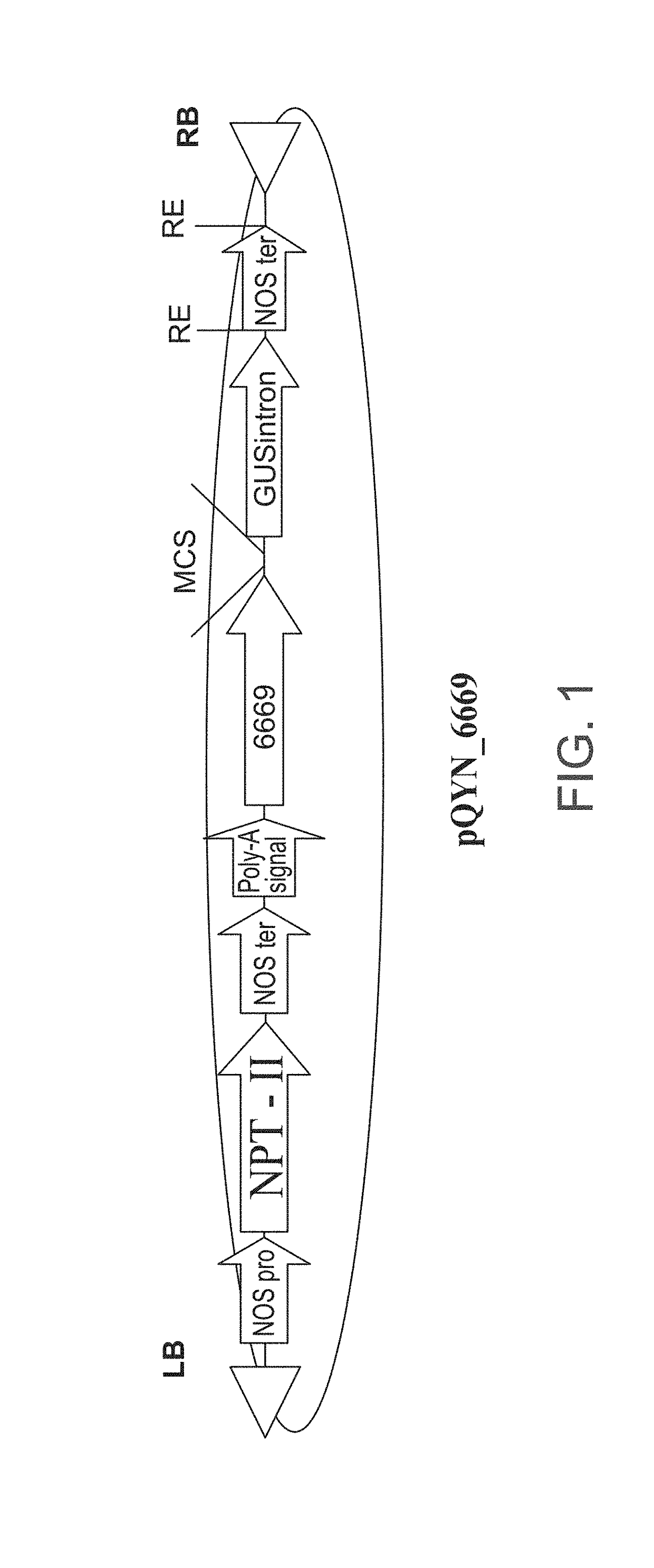Isolated polynucleotides and polypeptides, and methods of using same for increasing plant yield and/or agricultural characteristics
a technology which is applied in the field of isolated polynucleotides and polypeptides, can solve the problems of low nitrogen use efficiency, low yield of biofuel, and limited production rate of plant oil, etc., and achieves the effects of increasing biomass, abiotic stress tolerance, and/or nitrogen use efficiency of plants
- Summary
- Abstract
- Description
- Claims
- Application Information
AI Technical Summary
Benefits of technology
Problems solved by technology
Method used
Image
Examples
example 1
Bioinformatics Tools for Identification of Genes which Increase Abiotic Stress Tolerance, Yield and Agronomical Important Traits in Plants
[0537]The present inventors have identified polynucleotides which upregulation of expression thereof can increase abiotic stress tolerance (ABST), water use efficiency (WUE), yield, oil content, growth rate, vigor, biomass, fiber yield and quality, nitrogen use efficiency (NUE), and / or fertilizer use efficiency (FUE) of a plant.
[0538]All nucleotide sequence datasets used here were originated from publicly available databases or from performing nucleotide sequencing using the Solexa technology (e.g. Barley and Sorghum). Sequence data from 100 different plant species was introduced into a single, comprehensive database. Other information on gene expression, protein annotation, enzymes and pathways were also incorporated. Major databases used include:
[0539]Genomes[0540]Arabidopsis genome [TAIR genome version 6 (arabidopsis (dot) org / )];[0541]Rice gen...
example 2
Production of Sorghum Transcriptome and High Throughput Correlation Analysis with Yield, Nue, and Abst Related Parameters Measured in Fields Using 44K Sorghum Oligonucleotide Micro-Arrays
[0576]In order to produce a high throughput correlation analysis between plant phenotype and gene expression level, the present inventors utilized a sorghum oligonucleotide micro-array, produced by Agilent Technologies [chem. (dot) agilent (dot) com / Scripts / PDS (dot) asp?1Page=50879]. The array oligonucleotide represents about 44,000 sorghum genes and transcripts. In order to define correlations between the levels of RNA expression with ABST, yield and NUE components or vigor related parameters, various plant characteristics of 17 different sorghum hybrids were analyzed. Among them, 10 hybrids encompassing the observed variance were selected for RNA expression analysis. The correlation between the RNA levels and the characterized parameters was analyzed using Pearson correlation test [davidmlane (do...
example 3
Production of Sorghum Transcriptome and High Throughput Correlation Analysis with Biomass, Nue, and Abst Related Parameters Measured in Semi-Hydroponics Conditions Using 44K Sorghum Oligonucleotide Micro-Arrays
[0612]Sorghum vigor related parameters under high salinity (100 mM NaCl), low temperature (10±2° C.), low nitrogen conditions and normal growth conditions—Ten Sorghum hybrids were grown in 3 repetitive plots, each containing 17 plants, at a net house under semi-hydroponics conditions. Briefly, the growing protocol was as follows: Sorghum seeds were sown in trays filled with a mix of vermiculite and peat in a 1:1 ratio. Following germination, the trays were transferred to normal growth conditions (Full Hoagland containing 16 mM Nitrogen solution, at 28±2° C.), high salinity conditions (100 mM NaCl in addition to the Full Hoagland solution), low temperature conditions (10±2° C. in the presence of Full Hoagland solution), or low nitrogen conditions (the amount of total nitrogen w...
PUM
| Property | Measurement | Unit |
|---|---|---|
| Fraction | aaaaa | aaaaa |
| Fraction | aaaaa | aaaaa |
| Temperature | aaaaa | aaaaa |
Abstract
Description
Claims
Application Information
 Login to View More
Login to View More - R&D
- Intellectual Property
- Life Sciences
- Materials
- Tech Scout
- Unparalleled Data Quality
- Higher Quality Content
- 60% Fewer Hallucinations
Browse by: Latest US Patents, China's latest patents, Technical Efficacy Thesaurus, Application Domain, Technology Topic, Popular Technical Reports.
© 2025 PatSnap. All rights reserved.Legal|Privacy policy|Modern Slavery Act Transparency Statement|Sitemap|About US| Contact US: help@patsnap.com



